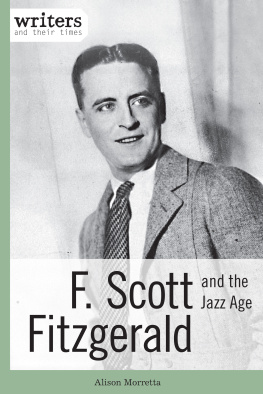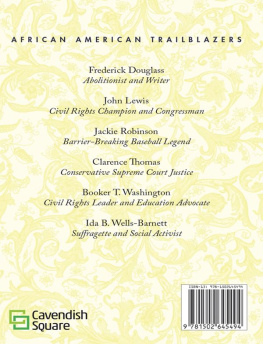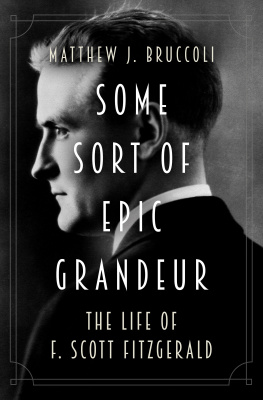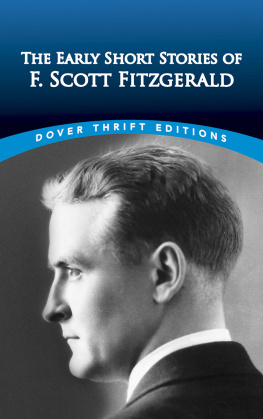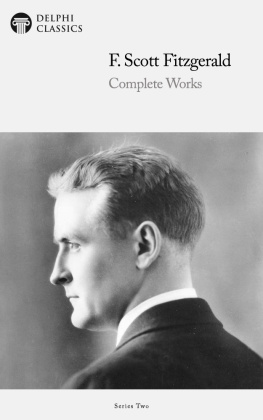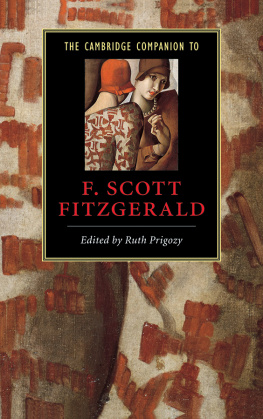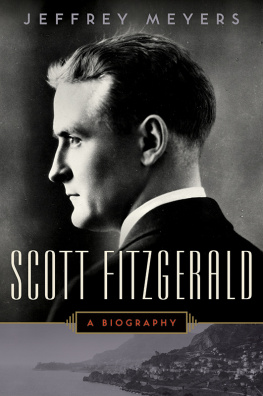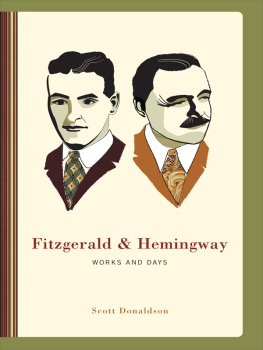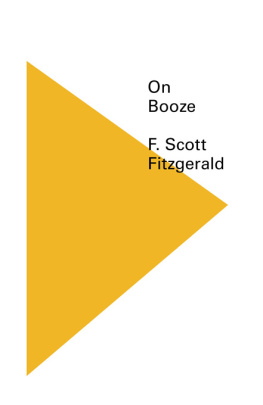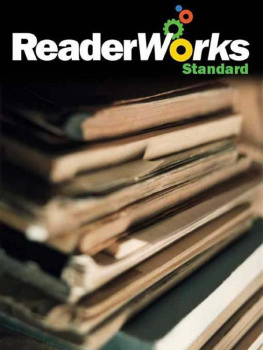Alison Morretta - F. Scott Fitzgerald and the Jazz Age
Here you can read online Alison Morretta - F. Scott Fitzgerald and the Jazz Age full text of the book (entire story) in english for free. Download pdf and epub, get meaning, cover and reviews about this ebook. year: 2014, publisher: Cavendish Square Publishing, LLC, genre: History. Description of the work, (preface) as well as reviews are available. Best literature library LitArk.com created for fans of good reading and offers a wide selection of genres:
Romance novel
Science fiction
Adventure
Detective
Science
History
Home and family
Prose
Art
Politics
Computer
Non-fiction
Religion
Business
Children
Humor
Choose a favorite category and find really read worthwhile books. Enjoy immersion in the world of imagination, feel the emotions of the characters or learn something new for yourself, make an fascinating discovery.
- Book:F. Scott Fitzgerald and the Jazz Age
- Author:
- Publisher:Cavendish Square Publishing, LLC
- Genre:
- Year:2014
- Rating:5 / 5
- Favourites:Add to favourites
- Your mark:
- 100
- 1
- 2
- 3
- 4
- 5
F. Scott Fitzgerald and the Jazz Age: summary, description and annotation
We offer to read an annotation, description, summary or preface (depends on what the author of the book "F. Scott Fitzgerald and the Jazz Age" wrote himself). If you haven't found the necessary information about the book — write in the comments, we will try to find it.
Readers learn about the exciting life and times of F. Scott Fitzgerald, the era of the Jazz Age, and its influence on Fitzgeralds greatest works.
F. Scott Fitzgerald and the Jazz Age — read online for free the complete book (whole text) full work
Below is the text of the book, divided by pages. System saving the place of the last page read, allows you to conveniently read the book "F. Scott Fitzgerald and the Jazz Age" online for free, without having to search again every time where you left off. Put a bookmark, and you can go to the page where you finished reading at any time.
Font size:
Interval:
Bookmark:


For Bart
Published in 2015 by Cavendish Square Publishing, LLC
243 5th Avenue, Suite 136, New York, NY 10016
Copyright 2015 by Cavendish Square Publishing, LLC First Edition
No part of this publication may be reproduced, stored in a retrieval system, or transmitted in any form or by any means electronic, mechanical, photocopying, recording, or otherwisewithout the prior permission of the copyright owner. Request for permission should be addressed to Permissions, Cavendish Square Publishing, 243 5th Avenue, Suite 136, New York, NY 10016. Tel (877) 980-4450; fax (877) 980-4454.
Website: cavendishsq.com
This publication represents the opinions and views of the author based on his or her personal experience, knowledge, and research. The information in this book serves as a general guide only. The author and publisher have used their best efforts in preparing this book and disclaim liability rising directly or indirectly from the use and application of this book.
CPSIA Compliance Information: Batch #WS14CSQ
All websites were available and accurate when this book was sent to press.
Library of Congress Cataloging-in-Publication Data
Morretta, Alison.
F. Scott Fitzgerald and the Jazz Age / Alison Morretta. pages cm. (Writers and their times)
Includes bibliographical references and index.
ISBN 978-1-62712-815-5 (hardcover) ISBN 978-1-62712-817-9 (ebook)
1. Fitzgerald, F. Scott (Francis Scott), 1896-1940Criticism and interpretation. 2. United StatesHistory1919-1933. 3.
Nineteen twenties. I. Title.
PS3511.I9Z735 2015 813.52dc23
2014003728
Editorial Director: Dean Miller Editor: Kristen Susienka Senior Copy Editor: Wendy A. Reynolds Art Director: Jeffrey Talbot
Designer: Amy Greenan Production Manager: Jennifer Ryder-Talbot Production Editor: David McNamara Photo Research: J8 Media
The photographs in this book are used by permission and through the courtesy of: Cover photo, AP Photo/File; Margaret Bourke-White/The LIFE Images Collection/Time & Life Pictures/Getty Images, 5; New York Daily News Archive/Getty Images, 6; File:Migrant family looking for work in the pea fields of California - NARA - 196057.tif/Wikimedia Commons, 7; General Photographic Agency/Hulton Archive/Getty Images, 8; FPG/Archive Photos/Getty Images, 10; John Parrot/Stocktrek Images/Getty Images, 11; Harris & Ewing/File:Warren G Harding-Harris & Ewing.jpg/Wikimedia Commons, 12; John Garo/File:Calvin Coolidge-Garo.jpg/Wikimedia Commons, 13; General Photographic Agency/ Hulton Archive/Getty Images, 14; Library of Congress, 15; Imagno/Hulton Archive/Getty Images, 17; General Photographic Agency/Hulton Archive/Getty Images, 19; Underwood Photo Archives/SuperStock, 20; New York Daily News Archive/Getty Images, 21; Hulton Archive/Getty Images, 23; GAB Archive/Redferns/Getty Images, 24; Tammy Lo from Brooklyn, NY/File:United Palace Balcony.jpg/Wikimedia Commons, 24-25; Elwin Williamson/Photolibrary/Getty Images, 26; File:Herbert Hoover - NARA - 532049.jpg/Wikimedia Commons, 27; Underwood Archives/Archive Photos/Getty Images, 29; Hulton Archive/Archive Photos/Getty Images, 30; Princeton University Library, 33; Alfred Hutter aka Gentry/File:Princeton---University---Blair-Hall---Rear-View---(Gentry).jpg/Wikimedia Commons, 36-37; Chicago History Museum, 37; New York World-Telegram and the Sun staff photographer/File:Maxwell Perkins NYWTS.jpg/Wikimedia Commons, 38; Mondadori/Getty Images, 39; Hulton Archive/Archive Photos/Getty Images, 41; Saturday Evening Post/File:Fitzgerald, Saturday evening post.png/Wikimedia Commons, 42; omgitsgeorgia.tumblr.com/File:Beautifuldamned.jpg/Wikimedia Commons, 43; Berthold Werner/File:Menton BW 0.JPG/Wikimedia Commons, 45; Everett Collection/Newscom, 46; Mary Evans Picture Library/The Image Works, 48; Pictorial Parade/Archive Photos/Getty Images, 50; Hulton Archive/Archive Photos/Getty Images, 52; JayHenry/File:F. Scott and Zelda Fitzgerald grave.png/Wikimedia Commons, 53; Dennis Van Tine/ABACAUSA.COM/Newscom, 54; Quantockgoblin/File:Princeton University Alexander.jpg/Wikimedia Commons, 56; Small-bones/File:University Cottage Club Princeton.JPG/Wikimedia Commons, 58; Pictorial Press Ltd/Alamy, 61; General Photographic Agency/ Hulton Archive/Getty Images, 62; Heritage Images/Hulton Archive/Getty Images, 66; Oli Scarff/Getty Images, 68; AP Photo, 70-71; Time Magazine/File:Time Cover in 1924-08-25.JPG/Wikimedia Commons, 72; AP Photo, 73; Library of Congress, 78-79; Frank Driggs Collection/ Archive Photos/Getty Images, 82; Everett Photo Collection/age fotostock, 83; Underwood Archives/Archive Photos/Getty Images, 92-93.

Introduction
ONE
TWO
THREE
FOUR
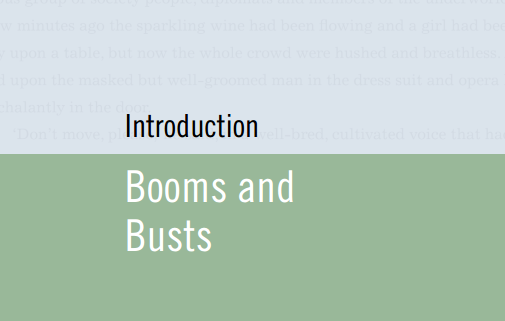
T he story of F. Scott Fitzgerald is the story of Jazz Age America. A member of The Lost Generation that came of age during World War I, Fitzgeralds rapid rise and fall mirrored the boom and bust of the Roaring Twenties. Where some men invested their life savings in the stock market, Fitzgerald invested everything in his work and his wife, Zelda. Both had disastrous consequences.
Fitzgerald was both a chronicler and a critic of Jazz Age culture. He spent his youth aspiring to fame and success, which he achieved at a very young age with the publication of his first novel, This Side of Paradise, in 1920. The publication of his novel coincided with the beginning of the Roaring Twenties, and the possibilities of the new decade seemed endless for the young author. However, though he enjoyed the lifestyle that accompanied his newfound celebrity, he remained critical of the Jazz Age culture of excess. His traditional Midwestern values stood in stark contrast to the new American Dream of fame and fortune, and he saw the nation in a state of moral decline.

Uniformed bartenders serve alcohol to customers in a New York City speakeasy in 1933, shortly before the repeal of Prohibition.
His work is a testament to his conflicting attitudes about the time he lived in.
The Jazz Age was a time of great change in American culture. A booming economy gave the impression that money was there for the taking. The ban on alcohol during Prohibition made millionaires out of criminals. The modern woman emerged as a cultural symbol and attitudes toward sexuality and gender roles were changing. It was in this environment that Fitzgerald came of age, and his work can be read as both a social history of his time and a critique of it.
While Fitzgerald became famous for his realistic portrayal of Jazz Age culture, he also became an alcoholic. Despite his literary success, he always found himself in need of money, and he came to further resent the culture that valued wealth and success above all things. Fitzgeralds own pursuit of the new American Dream left him broke and in poor health, and by the time of the Great Stock Market Crash in 1929, his career and his life were in shambles.

Font size:
Interval:
Bookmark:
Similar books «F. Scott Fitzgerald and the Jazz Age»
Look at similar books to F. Scott Fitzgerald and the Jazz Age. We have selected literature similar in name and meaning in the hope of providing readers with more options to find new, interesting, not yet read works.
Discussion, reviews of the book F. Scott Fitzgerald and the Jazz Age and just readers' own opinions. Leave your comments, write what you think about the work, its meaning or the main characters. Specify what exactly you liked and what you didn't like, and why you think so.

